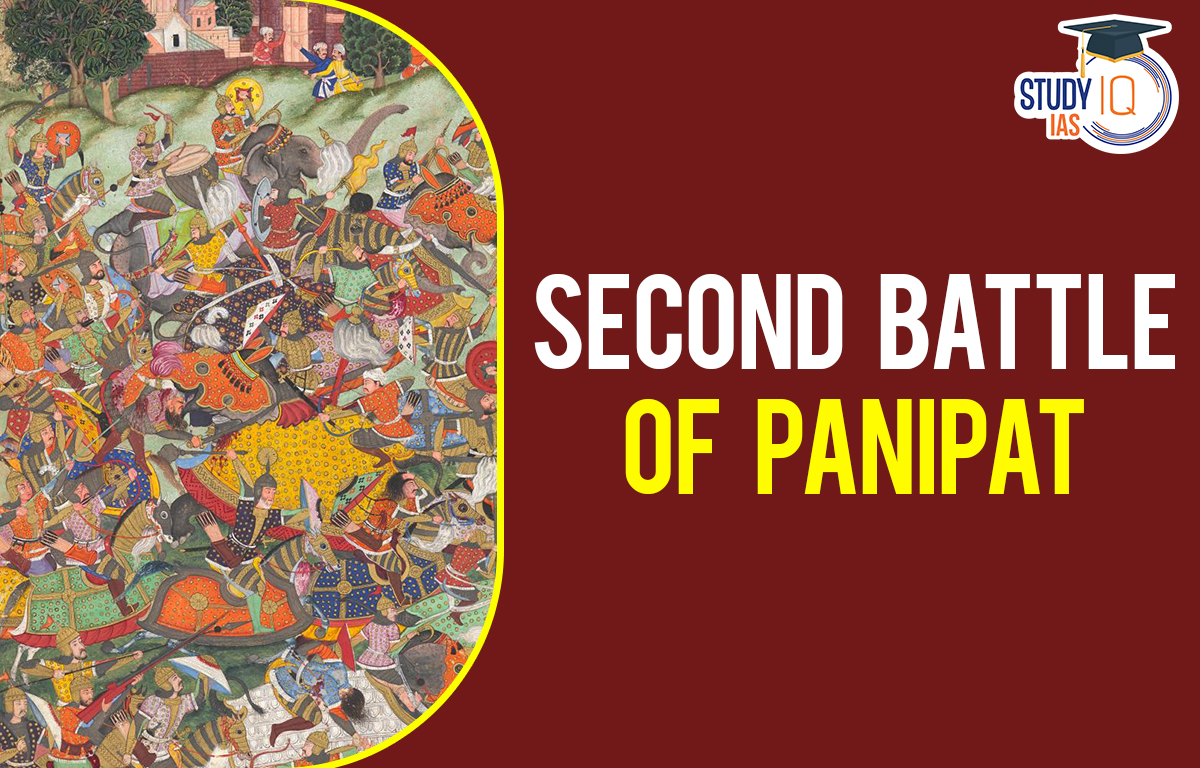Table of Contents
Second Battle of Panipat
The Second Battle of Panipat took place on November 5, 1556, between the forces of the Emperor of North India, Hemu, and the Mughal Emperor Akbar. The second battle of Panipat was a watershed moment in Indian mediaeval history, and as such, it is an important topic in the UPSC Syllabus’s Indian Medieval History section.
Read about: Bahadur Shah I
Second Battle of Panipat History
The Second Battle of Panipat was fought between the Hindu ruler Samrat Hem Chandra Vikramaditya, also known as Hemu, who ruled North India from Delhi, and Akbar’s army. It happened on November 5, 1556. Hemu had just won the Battle of Delhi, defeating the Mughals led by Tardi Beg Khan, and named himself Raja Vikramaditya during a coronation in Purana Quila in Delhi.
When Akbar and his guardian Bairam Khan discovered that Agra and Delhi had been lost, they marched to Panipat to reclaim the domains. The two armies met near the site of the 1526 First Battle of Panipat in Panipat. Akbar’s generals triumphed spectacularly.
Read about: Muhammad Shah
Second Battle of Panipat Reasons
Hemu led the attack, scattering his elephants across the Mughals’ right and left flanks. Instead of retreating, those troops who were able to flee the rampage chose to attack Hemu’s cavalry’s flanks, pelting them with their superior archery. The Mughal centre advanced as well, assuming a defensive position in front of a steep ravine.
Hemu’s elephant and horse units were unable to cross the chasm, leaving them vulnerable to projectile weapons thrown from the other side. Meanwhile, the Mughal cavalry, riding swift mounts, had infiltrated the Afghan ranks from both flanks and the rear and began attacking the elephants, slicing their legs or killing their riders. Hemu and his elephants were forced to retreat, and the Afghan assault was called off.
When the Afghan charge slowed, Ali Quli Khan led his cavalry out, circled around, and descended on the Afghan centre from behind. Hemu, who was standing nearby, moved quickly to counter the charge. Even after the deaths of Shadi Khan Kakkar and Bhagwan Das, he led counter-attacks against the Mughals, annihilating anyone who dared to challenge his elephants.
Despite the fact that the battle was fierce, Hemu appeared to have the upper hand. Hemu and his forces were numerically superior. Hemu, on the other hand, was knocked out by an arrow in the middle of the fight. When they saw their leader fall, his army panicked and dispersed. Bairam Khan kidnapped and beheaded Hemu while he was unconscious and nearly dead. This battle was won by the Mughals.
Read about: Battle of Buxar
Second Battle of Panipat Events
Although Hemu’s army outnumbered the Mughal army numerically, Hemu’s army had far more cavalry and elephants. Furthermore, they were battle-tested veterans from Bengal to Punjab. What the Mughals lacked in numbers, they compensated for with technology.
The captured artillery would even the odds in the upcoming battle. Both armies formed a formation and waited for the other to make their first move. Hemu launched the attack, unleashing his elephants on the Mughals. The resulting charge shattered the Mughal ranks and formation, but instead of retreating, the Mughals used missiles to attack the sides of Hemu’s cavalry. Due to the presence of a deep chasm, the elephants were unable to reach the majority of the Mughal army. Soon after, the Elephants were attacked by Mughal cavalry, forcing Hemu to flee.
Seeing the Afghans’ momentum waning, the Mughal Cavalry charged and encircled the Afghan centre. Hemu personally led a charge to prevent the encirclement after witnessing it. Despite the loss of his lieutenants, he led counterattack after counterattack with the elephants he still had. The charge paid off, however, as the Mughals’ crushing losses began to mount. Taking full advantage of the chaos caused by his heavy cavalry, Hemu drove back the Mughal army’s wings and arrayed his forces to crush the Mughal centre. He was, however, struck in the eye by a Mughal arrow and rendered unconscious as a result.
When the Afghan army saw this, it panicked and broke formation, retreating headlong. The Mughals ultimately won the battle. Hemu’s army suffered 5000 casualties, while Mughal losses were minor in comparison.
Read about: Later Mughal
Second Battle of Panipat Aftermath
Hemu was captured and brought to the Mughal camp hours after the battle ended. Bairam Khan executed Hemu while he was near death and unconscious. Some of his supporters and relatives were also killed as a warning to anyone considering rebelling against the Mughal Empire.
Adil Shah fared no better after Hemu’s death. Khazir Khan defeated and killed him in a battle in Bengal in April 1557. Hemu’s elephants were later integrated into the Mughal Army, and as a result, they became the empire’s mainstay for many years. The Second Battle of Panipat would consolidate Mughal power in North India, providing them with a base from which to conquer the rest of the Indian subcontinent in the years ahead.
Read about: Battle of Plassey
Second Battle of Panipat UPSC
Because of its strategic importance, Panipat was an important area for military and political purposes. Because of its proximity to the Ganga Yamuna region, this area was also economically significant. The Second Battle of Panipat was crucial in establishing Akbar’s rule. Students Preparing for UPSC can visit the official websites of StudyIQ UPSC Online Coaching for more details about UPSC Examinations.
Read about: Farrukh Siyar


 Jallianwala Bagh Massacre, Date, History...
Jallianwala Bagh Massacre, Date, History...
 Important Lakes of India, State wise and...
Important Lakes of India, State wise and...
 Buddhism History, Origin, Sect, Councils...
Buddhism History, Origin, Sect, Councils...





















